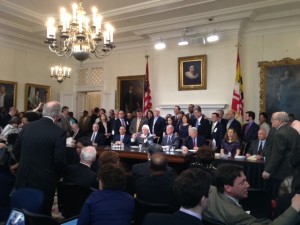
With his signature, Governor O’Malley initiated the process outlined in the bill that will result in the construction of turbines off the coast of Ocean City. The Maryland Offshore Wind Energy Act of 2013 creates a mechanism to incentivize the development of a major 200 megawatt offshore wind facility and establish a regulatory framework that will allow additional projects to interconnect in Maryland.
The law provides a “strike zone” of ratepayer protections only allowing the Public Service Commission (PSC) to approve a proposed offshore wind farm if it projects that the additional ratepayer impact is below $1.50 per household or 1.5 percent for non-residential customers.Developers must demonstrate that any project proposed will result in a net economic benefit to the state by creating jobs, economic development and protecting public health. The 2013 legislation also contains a $10 million Offshore Wind Business Development Fund targeted to small and minority businesses to assist them in preparing to participate in this new industry.
Working with the U.S. Department of Interior, Maryland agencies have helped designate a Maryland “Wind Energy Area” 10 nautical miles east of Ocean City that is expected to be leased to developers later this year.
Governor O’Malley and all of Maryland’s leaders deserve great praise and appreciation for stepping up and creating a path forward for offshore wind development in our state. This is precisely the kind of leadership needed at this moment in time to jumpstart a robust offshore wind industry in America. This accomplishment not only means healthier air, cleaner energy, and more jobs for Maryland, but also signals the growing momentum for offshore wind energy along the entire Atlantic Coast. Here are a few highlights:
- Massachusetts: In New Bedford, MA, major investments are being made to expand the South Terminal port facility in order to support the construction and operation of Cape Wind and future offshore wind projects. Cape Wind is expected to commence construction this year, and the Department of the Interior (DOI) is expected to issue additional leases off of New England via auction later this year.
- Rhode Island: A 30 MW demonstration project is moving forward in state waters off Block Island, with plans to also commence construction this year. DOI is on track to auction leases for additional offshore wind project sites later this year.
- New Jersey: In anticipation of major offshore wind development, the firm Weeks Marine has begun construction of a multi-million-dollar vessel designed specifically to install offshore wind turbines.
- Virginia: Dominion has received Department of Energy funding for an offshore wind demonstration project, and is one of eight entities that has expressed interest in securing a lease for an offshore wind project in the federally designated Wind Energy Area off of Virginia. DOI is expected hold a lease auction for this site before the end of the year.
- Mid-Atlantic Transmission: The DOI also cleared the way for the company Atlantic Wind Connection – with investment support from Google, Inc. — to receive right-of-way approval for an ocean-based transmission line, pending additional review.
- Federal Tax Incentives: The Investment Tax Credit (ITC) is critical for offshore wind development and provides a strong market signal to energy investors. Congress is currently considering a proposal to extend the current tax credit, which is set to expire at the end of 2013.
- Federal Investments: In early December, the U.S. Department of Energy announced seven offshore wind awards for projects in Maine, New Jersey, Ohio, Oregon, Texas and Virginia. As part of the Energy Department’s broader efforts to launch an offshore wind industry in the United States, these engineering, design and deployment projects will support innovative offshore installations in state and federal waters for commercial operation by 2017.
The National Wildlife Federation is working with a broad coalition of partners to build momentum and support for the rapid, responsible development of our offshore wind energy resources. Building clean energy is critical to protect wildlife from the dangers of climate change, but we must also be sure that strong conservation principles guide our offshore wind development activities. In a first of its kind collaboration, NWF and a coalition of leading environmental organizations and offshore wind developers have reached an agreement on needed measures to protect critically endangered North Atlantic right whales during pre-development activities. This collaborative agreement between key ocean stakeholders helps expedite offshore wind development while ensuring protection of the Atlantic’s precious ecosystem.
To learn more about progress on Atlantic Offshore Wind development and its significant potential to power our homes and businesses with clean, renewable energy, please view our recent report The Turning Point for Atlantic Offshore Wind Energy: Time for Action to Create Jobs, Reduce Pollution, Protect Wildlife & Secure America’s Energy Future
 Offshore Wind Energy
Offshore Wind Energy 

